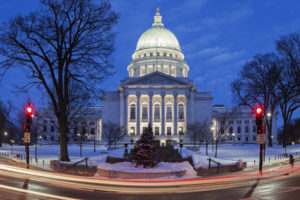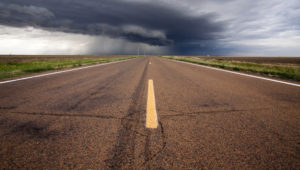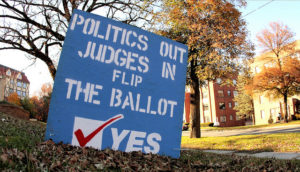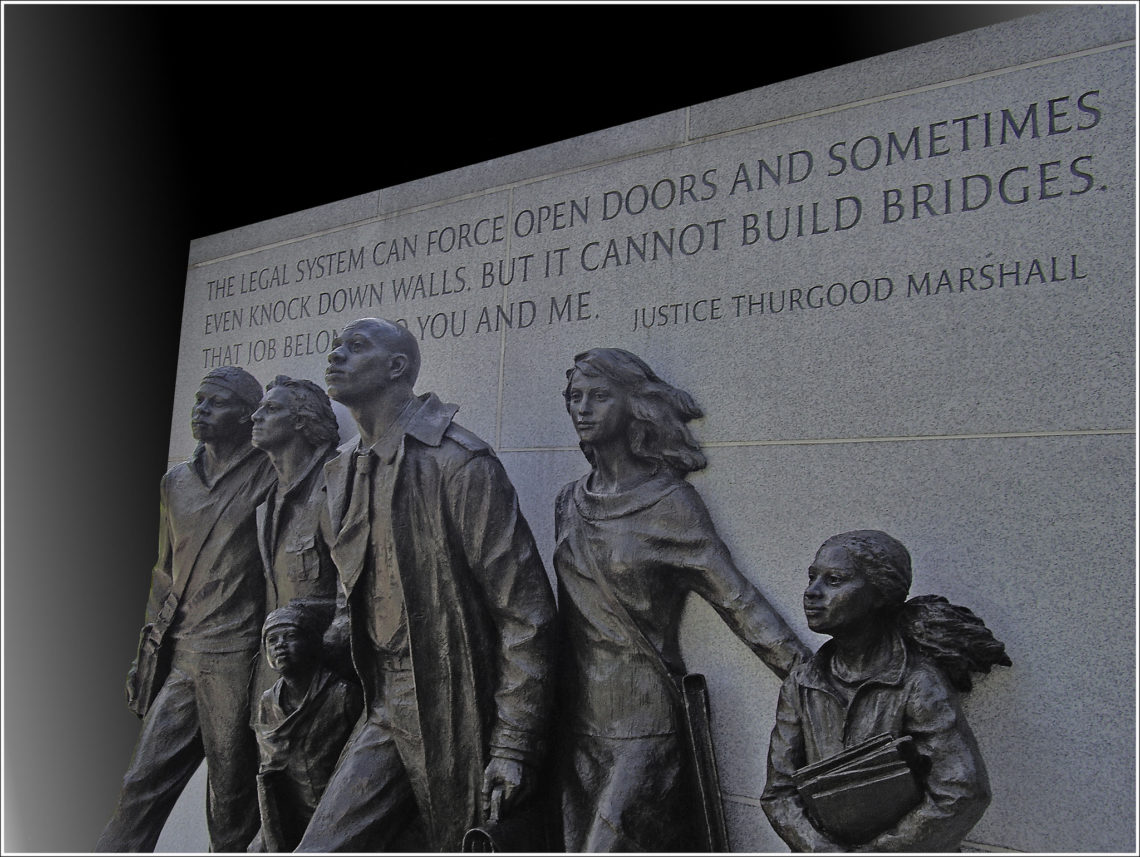Throughout the 2016 election year, Life of the Law’s team of investigative reporters, editors, and scholars partnered to research, produce and publish this five part series on the impact of money and politics on the public’s access to fair state courts.
On November 1st, Life of the Law published Judges v Attack Ads, the fifth and final part in the series. On November 23 and December 23, Life of the Law will present the entire series in two one-hour special episodes, that will include updates on each of the stories and a conversation with legal scholars on the impact of money and politics on the public’s access to fair state courts. Stay tuned.
![]()
Part 1: REVOLUTION IN A CORNFIELD – March 8, 2016

Kansas state legislators are locked in a balance-of-power fight with justices on the Kansas Supreme Court over how much of the state’s diminishing tax revenue to spend on educating children.
Life of the Law’s award-winning reporter Ashley Cleek reports on the fight from the classroom to courthouse. Throughout the state, teachers and school administrators are struggling with deep budget cuts, while in Topeka the funding fight has turned into a heated debate over the balance of power between the three branches of government.
Part 2: RIG THE SYSTEM – April 19, 2016

For many people living in small towns in America, having influence over their local government is a badge of honor. Some states, like Ohio, have gone so far as to amend their state constitution to grant special powers of self-governance, known as “home rule.” Home rule means cities have the power to govern themselves, as long as the city’s laws don’t conflict with state and federal laws.
It all seemed pretty clear. That was until the arrival of the domestic oil boom. In Ohio the drilling promised landowners riches if they were willing to allow a company to drill in their backyards. Many Ohioans scrambled to get a piece of the extraction action, pitting those willing to put up with the disruption of drilling against neighbors who don’t want to live next door to an oil well. But when it comes to drilling for oil, reporter Jonathan Hirsch asks who under the law has the power to decide who can drill, and where?
Part 3: RECUSE YOURSELF – May 17, 2016

Judges are supposed to hear cases before them and make fair judgements based on the law. But what if a judge has a bias? Maybe a conflict of interest? When should a judge step aside or recuse themself from hearing a case?
If a judge’s family member has an interest in a case before the judge’s court, most people would agree the judge should step aside. Recuse themself. Bow out. What if a judge stands to directly profit from the outcome a case? That seems pretty cut and dry too. But what if one of the parties in a case being heard by a judge contributed money to the judge’s campaign in a judicial election? What then?
As money floods into judicial elections throughout the country, states grapple with this question. Perhaps no state more than Wisconsin, where as Chloe Prasinos reports, like in many other states, the final decision of whether or not a judge should step aside from hearing a case, or recuse themself, is left up to the judge.
Part 4: COURTING VOTERS – October 18, 2016

A severe thunderstorm passes over the highway in western Kansas
This is a strange election year. Nationally it’s Trump v Clinton and the Senate’s up for grabs. But it’s even weirder for judges in Kansas. It’s a retention election, which means it’s not two candidates squaring off against each other. Instead, it’s voters deciding whether they want to keep a justice on their state’s Supreme Court, or not. Yes or no. Up or down.
A bunch of states have used retention elections and for decades, they’ve been uneventful, low-key affairs. No big money. No negative ads. Every time Kansans have had the choice, they’ve voted to keep all of their judges on the court. But this election year the script’s been thrown out and the Kansas Supreme Court could completely change.
On October 4th, the justices on the Kansas Supreme Court traveled to Hutchinson, a small town in central Kansas. The seven men and women donned their black robes and took the bench in a community college auditorium to hear oral arguments in upcoming cases. This is pretty much the extent of campaigning the justices are allowed to do and for more than 50 years this has been enough.
This year, as Ashley Cleek reports from Kansas, many people say they are disillusioned by several rulings the justices on the state’s highest court have made and now they want to boot four of the five justices on the ballot from the bench. Never before has a sitting justice on the Kansas Supreme Court not won a retention election. But as we all bear witness, 2016 is a different sort of election year.
Part 5: JUDGES v ATTACK ADS – November 1, 2016

Judges across the country are in a fight to keep their jobs. Unlike judges appointed to federal courts, many state judges run in elections to either get voted onto the court or keep their seat on the bench after they’ve been appointed and that means they have to convince voters to vote for them. So judges do what candidates in elections do: they go to state fairs, they shake hands, they kiss babies, and they spend hours on the phone fundraising. And, now they dodge harsh attack ads.
Fifteen years ago, judges were pretty much exempt from attack ads. But today, independent groups pour millions of dollars into state judicial races hoping to influence voters, one way or another.
In Part 5 of our series on A Fair Fight for a Fair Court, Jess Engebretson reports on the rise of attack ads in judicial elections.
![]()
Life of the Law’s special series on A Fair Fight for a Fair Court was reported by Ashley Cleek, Jonathan Hirsch, Chloe Prasinos and Jess Engebretson; edited by Ibby Caputo, Nancy Mullane and Annie Aviles; sound designed and produced by Jonathan Hirsch, Shani Aviram and Tony Gannon; with post production by Kirsten Jusewicz-Haidle, Alyssa Bernstein and Rachael Cain. Our Advising Scholars on the series were Valerie Hans of UC Irvine, James Gibson of Washington University, Elizabeth Joh of UC Davis, Heather Thompson of the University of Michigan and Anna Maria Marshall of University of Illinois and the University of Chicago College of Law.
Our series photo is of the Virginia Civil Rights Memorial on the grounds of the Virginia State Capitol. Photo Credit: Ron Cogswell.
You can find all of the episodes on Panoply, iTunes, Public Radio Exchange.
This special series was funded in part by donations from our listeners and by grants from the Open Society Foundations, the Law and Society Association, the Proteus Fund, the Ford Foundation, and the National Science Foundation.
Our series was sponsored by Squarespace, The Great Courses Plus, Blue Apron, and the producers of the film Denial.
© Copyright 2016 Life of the Law. All rights reserved.









